At the end of the 1920s, pressure-sensitive tapes (PSTs) were extensively adopted in museums, libraries and archives. They have been found on records kept at The National Archives to repair tears and losses, to cover and change parts of text in documents, books and photographs. In some cases, they were even used as a writing support to add text/information or as part of an artwork.
Unfortunately the PSTs applied on documents, books, photographs and paper artworks as repairs can obscure information and historical images, hiding our past and knowledge. In addition they accelerate the degradation of the support material and artistic media, especially contemporary inks.
A brief history of PSTs
Pressure-sensitive tapes are a flexible material which adheres easily to surfaces with light pressure. They are composed of four layers: backing, adhesive, primer coat that gives a good adhesion between the two layers, and the release coating that allows the easy unrolling of the tape during use (Fig. 1). There are different types of backings such as fabric, paper, film (e.g. polypropylene, cellulose acetate) and other materials; the adhesives comprise acrylic copolymers, natural and synthetic rubbers and silicones. The most common tapes are fabric tape, masking tape, cellophane tape, magic tape and archival tapes that are Filmoplast P and P90.

PSTs have been used since 1845 in the medical sector – as sticking plasters. They were fabric tapes, often used in hospitals; the woven fabric represents the oldest backing material with natural or synthetic rubber adhesive. PSTs also appeared in the automotive industry from 1920, becoming easily available and simple to apply. In particular, masking tape has been used since 1925 as a mask for painting, and is characterized by crepe paper backing and natural or synthetic rubber-based adhesives. Cellophane is the oldest film tape, with a synthetic rubber adhesive and transparent backing made by regenerated cellulose. After that magic tape appeared in 1950, and it has a matte acetate backing with acrylic adhesive. Finally, Filmoplast P and P90 were invented by Hans Neschen International in 1970, for mounting, hanging and mending in the library, picture-framing and for use in the conservation sector. They have an acid-free paper backing; the first one is transparent, while the other one has a heavier backing paper. Both of them have an acrylic adhesive buffered withcalcium carbonate.
Damages caused by PSTs and treatments with minimal intervention approach in the context of conservation for digitisation
Due to their instability and degradation, PSTs can cause physical and chemical damage to paper. Physical damage could be deformations and undulations of the paper substrate. As pressure-sensitive tape with backing films and paper have different chemical compositions, they react differently to humidity and temperature, and if the environment fluctuates the two materials expand and contract at a different rates. Gradually over time this can create distortions in the area around the tape. Chemical damage can be caused by the oxidation that is a chemical alteration of the natural and/or synthetic rubber-based adhesives, such as the ones contained in masking tape and cellophane.
PSTs change over time in consistency and colour, and there are several stages of degradation. During the first stage the tapes and adhesive become yellow (Fig. 2); as the adhesive starts to penetrate further into the paper fibres, it can become sticky and oily. In the last stage, the adhesive can become hardened, dark brown and lose its adhesive properties (Fig. 3). In conjunction with the adhesive degrading, PSTs with a solvent-based acrylic adhesive like film tape can interact with contemporary inks such as ballpoint pen and more, producing alterations like bleeding ink, which is where the ink soaks through the paper onto adjacent materials (Fig. 4).
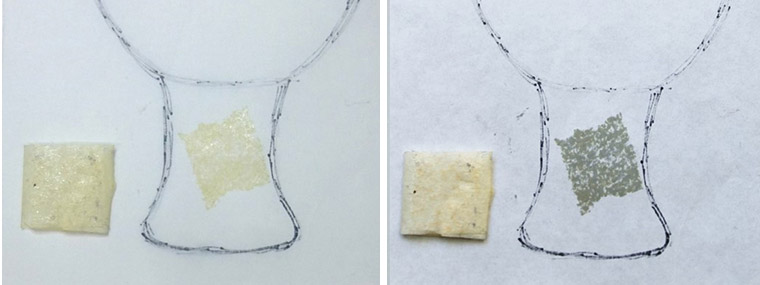

The damage caused by these tapes can be treated with a variety of techniques, depending on the materials, tapes and levels of degradation. Commonly, conservators use tools like scalpels, different types of spatula, tweezers, erasers, silicon paper, hot air, solvents, or gels to remove the tape. In the context of conservation for digitisation our treatments are focused on a minimal intervention approach, and the assessment of conservation treatments to undertake on PSTs depends on two factors:
- The visibility of the text/image area that can be rendered illegible when covered by PSTs.
- The safe handling of the object itself. Safe handling is ensured by stabilising any weak areas of the document that may become damaged during the digitisation process. In many institutions, like The National Archives, a team of conservators stabilise documents before they are scanned and imaged.
The care and treatments on PSTs for the safe handling of an object are undertaken when the damage could expand during the digitisation process, for example when the PST used to repair a tear has lost the backing but the adhesive is still sticky and therefore could stick on any surface, causing further damages.
Case study: ‘Sex & Sexuality’
PST treatments were used during the 2019 large-scale digitisation project, ‘Sex & Sexuality’. This project included historical documents including tagged files, newspapers, maps, photographs and bound volumes with a poor quality wood pulp paper. The text and image were often obscured by brown and white paper tape that severely reduced the visibility of the text. When examining the documents we found that film tape was often used to repair tears (Fig. 5) or to reattach fragments, and in some cases it was used as a writing support to add parts of text (Fig. 6).
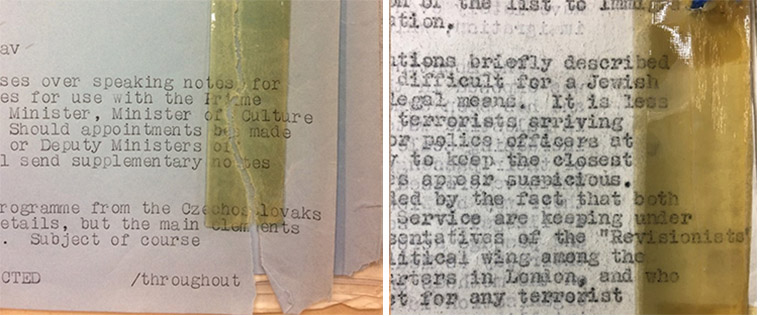
During the preparation of the documents for digitisation we first assessed the PSTs that required treatment, taking into account the principle of minimal intervention. As tape reduced the visibility of the text it was decided that most of the tape would be removed prior to digitisation; however, as there were many different types of tape in different degradation stages, multiple treatment approaches had to be taken. The choice of conservation treatment was done gradually, by starting with the less invasive tape removal methods (e.g. spatulas, scalpel, aqueous techniques by direct local applications and gels) and if necessary by continuing with more invasive treatments (e.g. solvent treatments).
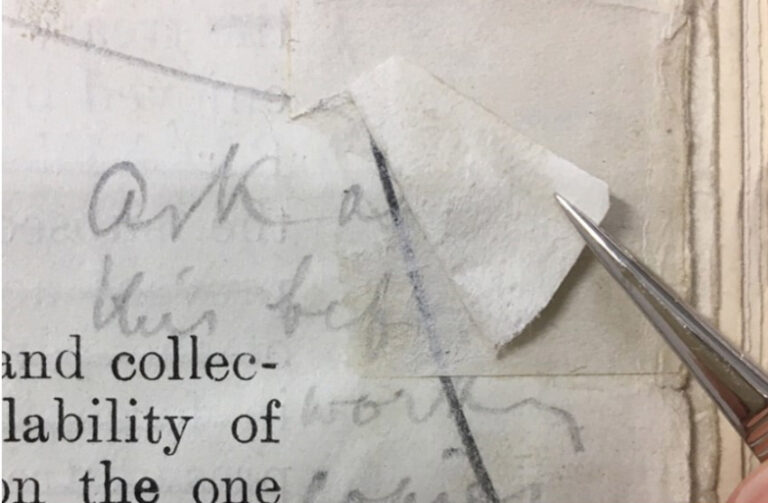
The white tape required a less invasive method and could be removed using a scalpel, spatula and tweezers (Fig. 7). The film tape was treated with scalpel, spatula, tweezers and hot spatula, in such a way that the backing and part of adhesive could be peeled off the paper; this treatment was undertaken only when the PST used to repair the tears was applied in such a way that the text did not correspond, becoming incomprehensible (Figs. 8, 9, 10, 11).
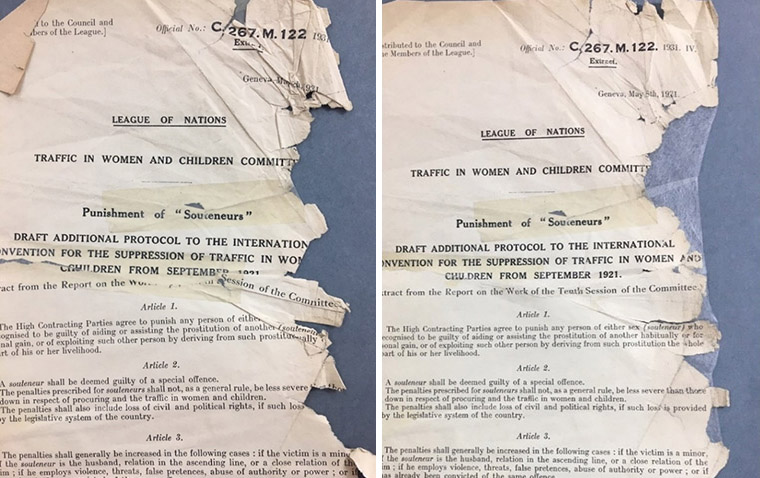



Finally, the brown tape required a more interventive approach where aqueous treatments were used. Solvent was applied locally with cotton swabs and/or water brush (Fig. 12) to soften the adhesive, and with gentle scraping with a scalpel the tape was removed. In the case where the film tape was used to repair tears and then became a writing support in itself, with original text, the tape was not removed. Instead the tape was repaired with gelatine-coated repair tissue to stabilise the item (Fig. 13).

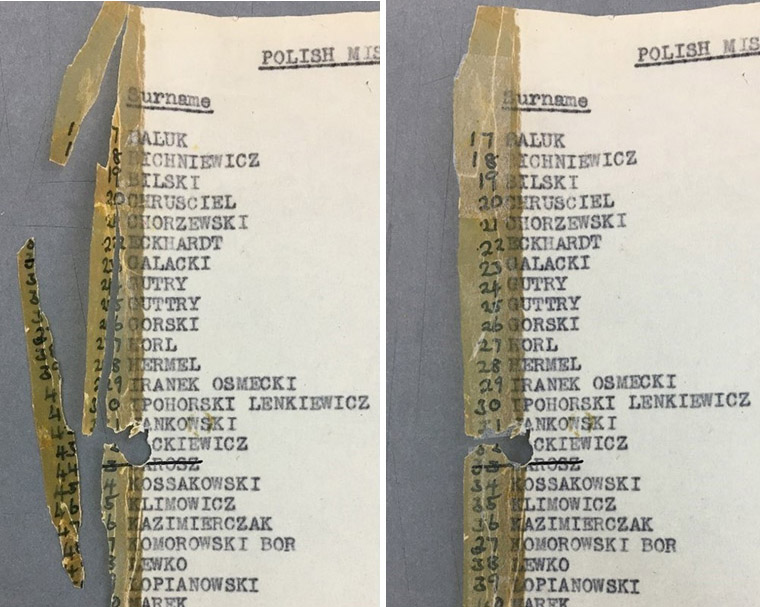
Conclusion
In the conservation for digitisation the removal and/or care of PSTs follows the principle of minimal intervention. All treatments are carried out with the aim to reveal and make the text and image legible, in order to ensure a safe handling of the object during the digitisation process. Our goal is to increase access to the collection, enable research and broaden the ability to pass on knowledge of cultural heritage collections to future generations.
References
Merrily A Smith, Norvell M M Jones, II, Susan L Page and Marian Peck Dirda. Pressure-Sensitive Tape and Techniques for its Removal From Paper. Available at https://cool.culturalheritage.org/coolaic/sg/bpg/annual/v02/bp02-13.html
Skeist, I (1990) Handbook of Adhesives. US: Springer
Neschen Coating GmbH. Filmoplat. Available at https://www.neschen.de/en/product/filmoplast-p-2/
Neschen Coating GmbH. Filmoplat P90. Available at https://www.neschen.de/en/product/filmoplast-p-90-2/
3M Office markets, Scotch® Magic™ tape 810. Available at
https://rexel-cdn.com/Products/B9E326A6-9121-4431-ABCE-836A8F3B2D5C/B9E326A6-9121-4431-ABCE-836A8F3B2D5C.pdf
Satas, D (1989) Handbook of Pressure-Sensitive Adhesive Technology. US: Springer
O’Loughlin, E M (2001) ‘Pressure-sensitive tape and our cultural heritage’, Tech-Tech Semin Proc. PSTC, pp. 223–232
Feller, R L, and D B Enke (1982) ‘Stages in deterioration: The examples of rubber cement and transparent tape’, Studies in Conservation, Volume 27, pp. 19-23
Mirabile, A, Chelazzi, D, Ferrari, P et al. (2020) ‘Innovative methods for the removal, and occasionally care, of pressure sensitive adhesive tapes from contemporary drawings’, Herit Sci 8, 42, pp. 1-16
Trabace, M, Mirabile, A, Montalbano, L, Giorgi, R, Ferrari, P, (2017) ‘An innovative method to remove pressure sensitive tape from contemporary felt-tip pen and ball-point pen drawings on paper. The case studies of Federico Fellini from Rimini film Library’, LE NUOVE FRONTIERE DEL RESTAURO – Trasferimenti, Contaminazioni, Ibridazioni – XXXIII° Convegno Internazionale Scienza e Beni Culturali Bressanone, pp. 849-859
Paper conservation catalogue. Hinge, Tape and Adhesive Removal. Available at https://cool.culturalheritage.org/coolaic/sg/bpg/pcc/15_hinge-tape-and-adhesive-removal.pdf
Tate Modern. Removal of Pressure Sensitive Tape from Works of Art on Paper. A Workshop by Antonio Mirabile. Available at https://www.tate.org.uk/about-us/projects/nanorestart/pst-removal-workshop
Workshop
Harvey, Ross and Mahard, Martha R, (2014) The Preservation Management Handbook. A 21st-Century Guide for Libraries, Archives, and Museums. Lanham: Rowman and Littlefield

As usual a fascinating post, not just on an aspect of the ‘back of house’ conservation activities at the National Archives – and by extension similar organisations – but also of use for amateur activists working with family documents.
We have known for a long time that adhesive tape was bad for paper-based materials and now we have a greater insight the subject.